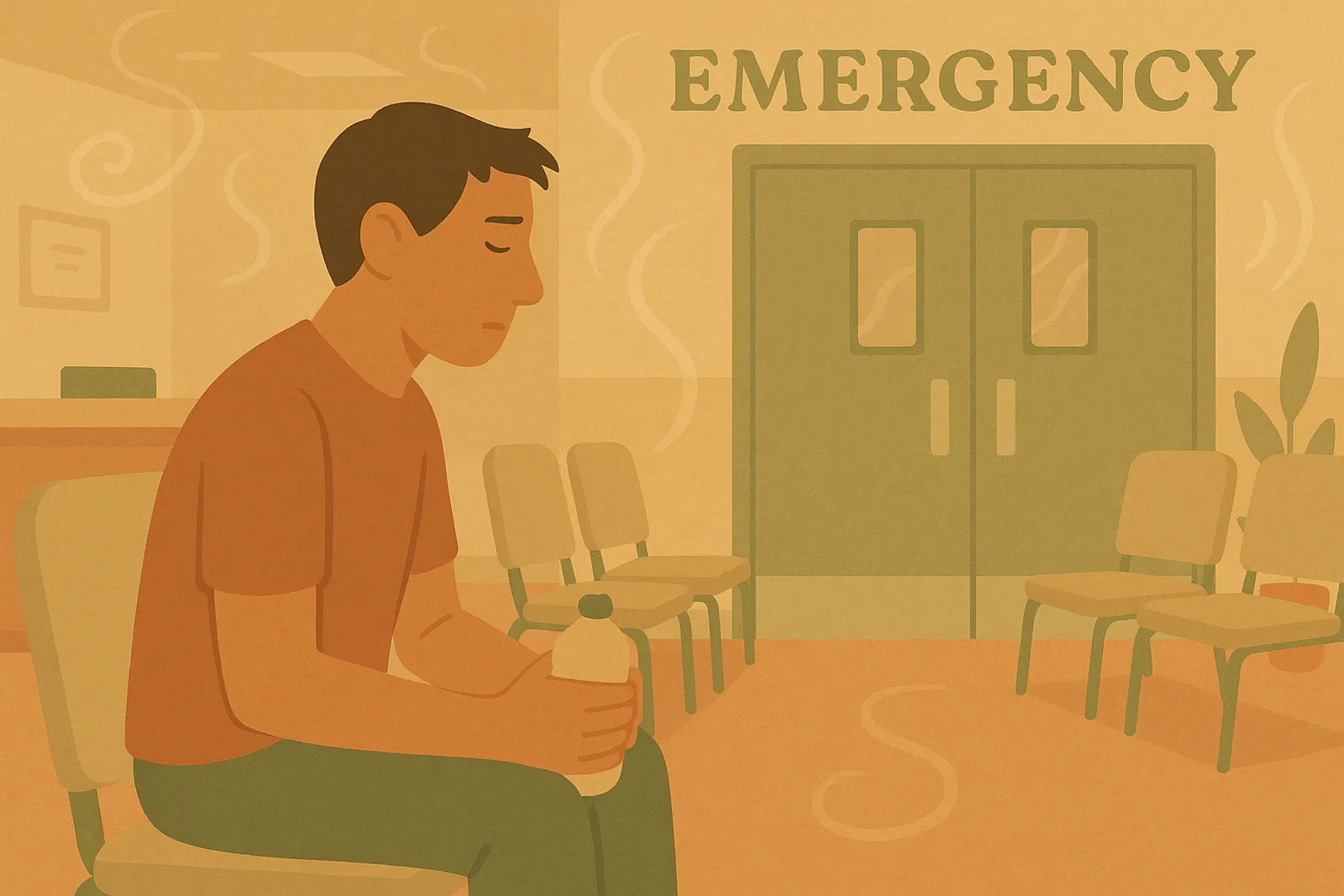CHS Emergency Room Guide: What to Expect and How to Prepare
Navigate emergency room visits effectively with this essential CHS guide. Learn precisely what to expect, how to prepare, essential items to bring, and the best ways to communicate your condition to healthcare professionals.

5 min read
Experiencing a Cannabinoid Hyperemesis Syndrome (CHS) episode can be frightening, especially when emergency care is necessary. This detailed guide outlines exactly what to expect during your ER visit and how to prepare effectively to reduce anxiety and ensure optimal care.
When Should You Visit the Emergency Room?
Immediate Signs to Seek Emergency Care
Head to the ER immediately if you experience:
- Severe dehydration (dizziness, confusion, rapid heartbeat)
- Continuous vomiting lasting over 24 hours
- Blood or coffee-ground appearance in vomit
- Severe, worsening abdominal pain
- Electrolyte imbalance symptoms (muscle cramps, irregular heartbeat, weakness)
- Loss of consciousness or fainting
- Chest pain or difficulty breathing
ER vs. Urgent Care: Know the Difference
Emergency Room: Severe symptoms, dehydration, intense pain, or life-threatening concerns.
Urgent Care: Mild to moderate symptoms, stable conditions needing IV fluids, and follow-up coordination.
Preparation Checklist: Before Heading to the ER
Essential Items to Bring
Medical Documentation:
- Insurance card and photo ID
- List of current medications
- Previous CHS diagnosis and recent lab results
- Primary care doctor’s contact details
CHS-Specific Details:
- Symptom diary and cannabis use history
- Previous CHS episode details
- Effective and ineffective past treatments
- Current symptom severity and duration
Comfort Essentials:
- Phone charger
- Comfortable clothing
- Support companion
- Small towel (for heat application)
- Tolerable clear fluids
Summarize Your Medical History
Prepare a concise, one-page summary including:
- Cannabis usage (frequency, duration, products)
- Past CHS episodes (dates, treatments, outcomes)
- Medications, allergies, medical conditions
- Recent symptom or usage changes
What to Expect During Your ER Visit
Initial Triage Assessment
Expect a quick evaluation of:
- Vital signs (blood pressure, heart rate, temperature)
- Pain level (scale of 1–10)
- Symptom description and onset
- Urgency determination
Typical questions asked include:
- “When did symptoms begin?”
- “Rate nausea/pain severity.”
- “Any recent substance use?”
- “Previous similar episodes?”
Medical Evaluation and Tests
Physical Examination:
- Abdominal check
- Hydration status
- Neurological, heart, and lung assessments
Common Tests:
- Blood tests (electrolytes, kidney function, complete blood count)
- Urinalysis (hydration, drug screening)
- Imaging tests (possible abdominal CT scans)
Treatments Offered
Immediate Treatments:
- IV hydration
- Anti-nausea medication (ondansetron, promethazine)
- Non-opioid pain relief
- Electrolyte replenishment
Comfort Measures:
- Hot packs for abdominal relief
- Calm, quiet environment
- Slow reintroduction of clear fluids
Effective Communication with Medical Staff
Explaining CHS Clearly
Use a simple, direct explanation:
“I have Cannabinoid Hyperemesis Syndrome (CHS), a condition triggered by chronic cannabis use causing severe vomiting, nausea, and abdominal pain. Hot showers help temporarily, but stopping cannabis is the only effective long-term treatment.”
Addressing Common Challenges
- Staff unfamiliar with CHS: Provide printed literature, reference medical studies, or request a gastroenterologist consultation.
- Skepticism about cannabis link: Highlight your symptom diary, correlation timing, and hot shower relief.
- Unsuitable medication suggestions: Clearly communicate past treatment effectiveness and sensitivities.
Managing Your Hospital Stay
Advocate for Yourself
- Request hot packs for comfort.
- Ask about room temperature adjustments.
- Clearly report symptom changes.
- Seek updates regularly.
ER Timeline Expectations
- 1–2 Hours: Initial assessment, IV fluids, and medication administration.
- 2–4 Hours: Review of test results, assessment of symptom relief.
- 4+ Hours: Planning discharge, coordinating follow-up care.
Before Discharge
Discharge Essentials
Ensure you have:
- Clear instructions and emergency return criteria
- Prescriptions and medication details
- Scheduled follow-up appointments
- Contact information for future questions
Ask specifically about:
- Symptoms requiring immediate return
- Follow-up scheduling
- Home management strategies
- Medication interactions
Financial and Insurance Considerations
Before Arrival
- Confirm ER insurance coverage.
- Clarify copays and deductibles.
- Have your insurance information ready.
Cost-Management Tips
- Choose in-network hospitals.
- Inquire about financial assistance.
- Request detailed billing.
- Appeal insurance rejections if necessary.
Follow-Up Care After the ER
Immediate Follow-Up Steps
- Contact your primary physician within 48 hours.
- Schedule gastroenterologist consultation.
- Initiate a cannabis cessation plan.
Ongoing Management
- Regular medical follow-ups
- Symptom tracking
- Nutrition and hydration management
- Mental health support as needed
Special Circumstances
Frequent ER Visits
- Document previous visits and treatments.
- Clearly explain your management strategies.
- Explore case management services.
Pregnancy
- Immediately inform medical staff.
- Discuss medication safety and specialized care.
- Seek OB/GYN consultation.
Mental Health
- Request emotional support resources.
- Consider professional counseling and support groups.
- Address anxiety or depression proactively.
Advocacy and Awareness
Sharing Your Experience
- Offer feedback to medical teams.
- Support CHS awareness initiatives.
- Participate in advocacy and educational efforts.
Emergency Resources and Contacts
Poison Control: 1-800-222-1222
Crisis Text Line: Text HOME to 741741
SAMHSA National Helpline: 1-800-662-4357
Final Thoughts
Seeking emergency care for severe CHS symptoms is justified and critical. Proper preparation, clear communication, and proactive self-advocacy can significantly improve your ER experience and health outcomes.
Did you find this article helpful? Help us keep creating free CHS resources.
❤️ Support CHS Awareness
